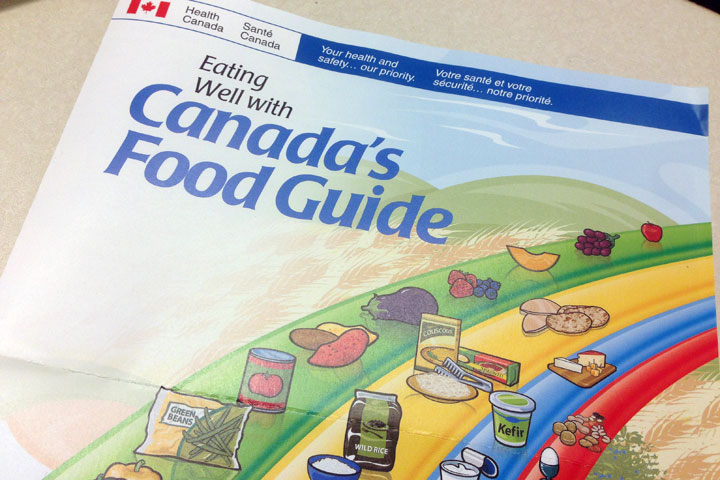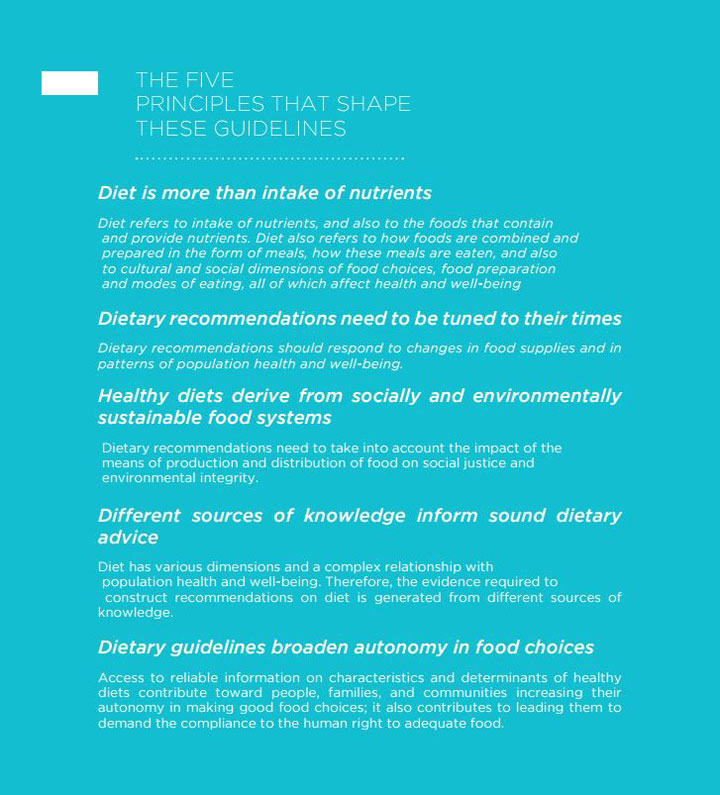It’s a cornerstone of Canada’s approach to healthy living, shapes our provincial nutritional policies, and is taught in schools.

Canada’s Food Guide – the iconic, colourful model to eating well. But is our national guide out of touch? Critics point to several flaws in the Food Guide that render it unrealistic and out of date.
Health Canada said the goal of the Food Guide is to ensure Canadians are meeting their nutritional needs. It also serves to reduce the risk of chronic diseases (like obesity, Type 2 diabetes, heart disease, cancer and osteoporosis) and helps improve overall health and vitality.
To this end, the Guide instructs consumers to eat a certain number of specific foods a day, depending on their age and gender.
READ MORE: Explaining Canada’s Food Guide and how it works
Health Canada said the Food Guide is to be used as just that – guidance. Serving sizes are suggested.
“A food guide is one tool in a broader strategy to support healthy eating,” said a spokesperson for Health Canada. “Food labels, education and outreach initiatives, and information products, such as modules for schools to use in nutrition education, all play a role in providing dietary guidance.”
But critics argue that what’s in the Guide matters as it does influence our choices.
“The Food Guide is actually quite important,” said Dr. Yoni Freedhoff. “It serves as the basis for all the institutional food programs, to our children, to patients in hospitals, in government-run buildings. But it also is taught to dietitians and doctors and nurses and other allied health professionals as gospel.”
“This is the country’s nutritional consciousness in a sense,” said Freedhoff.
Health Canada confirmed that the Guide is used by a number of stakeholders to “develop consistent messages on healthy eating across the nation.” For example, “the guidance from the Food Guide is adapted to the development of several of the provincial and territorial nutritional policies as well as school guidelines,” said Health Canada’s Alfred Aziz.
Experts call out ‘inherent flaws’
Why do critics think the Food Guide is out of date and out of touch? In short, it’s unrealistic and overly complicated – it doesn’t reflect our normal relationship with food.
“One problem with Canada’s Food Guide is that most people don’t actually know how to use it,” said registered dietitian Cara Rosenbloom.
“I think what’s confusing for most people is that there are different ages and genders and serving sizes at each age and gender, so that really trips people up sometimes, especially following a graph,” she said.
Rosenbloom said the confusion becomes even more pronounced for people who have literacy issues or aren’t strong in math. “Looking at a graph that has 20 or 30 numbers on it can be very, very confusing to follow,” she said.
Most people don’t weigh and measure their food, said Freedhoff. “Most Canadians think a serving of steak is however much steak they put on their plate, not that they have to divide it into 50 or 75 gram portions.”
Another inherent flaw of the Food Guide is that foods which fall outside of the four basic food groups don’t really have a place, said Rosenbloom.

Get weekly health news
“The guide ignores the fact that 25 per cent of calories Canadians are currently consuming are coming from other foods,” Freedhoff said.
Because there is no place in the Guide for ‘other’ – and we certainly eat a lot of food from that ‘other’ category — Freedhoff also argues that the amount of food recommended in a day is too much.
“To ignore the fact that Canadians are consuming a large amount of calories from other foods, and then telling those same Canadians to make sure they eat all of these servings that will in turn get their calories up pretty darn high, does lead to the possibility of Canadians gaining weight if they do follow the Food Guide.”
“I suppose that if Health Canada thinks that if we don’t mention them in the Food Guide then no one is going to eat them at all, and clearly we know from consumption patterns, that’s not what’s happening, especially with the levels of obesity where they’re at,” Rosenbloom said.
Health Canada said, however, that the Guide has been built so people wouldn’t exceed their daily calorie recommendations.
“Based on the nutrient needs of different age and sex groups, the Food Guide has been built so that to meet these nutrient needs, these people, based on the age and sex groups, would not exceed their caloric requirements,” said Aziz.
Juice is a fruit?
Another argument against the current Food Guide is that it allows for some foods that arguably shouldn’t be recommended in the Canadian diet.
Juice, for instance, is listed as an acceptable serving of fruit.
“Juice is basically liquid with a lot of natural sugar in it and it doesn’t have any of the fibre that comes naturally from fruit because it has been eliminated when the juice is pressed,” said Rosenbloom.
READ MORE: Will juice be dropped from Food Guide?
Freedhoff argues the list of questionable foods in the Guide goes well beyond juice:
“It only recommends the limitation of non-natural trans fats, not the avoidance of non-natural trans fats. It calls juice a fruit.
“It wrongly suggests that milk is a magic fairy food that deserves a food grouping in and of itself.
“It tells people that all protein is the same, that half of your carbohydrates can be refined without risk – all of these messages are simply untrue. And sadly there are more.”
Health Canada said that the Guide urges consumers to make sure half of their grain servings are whole grain, to opt for lean meats and products low in fat, sugar or salt.
It also recommends limiting items such as cakes, candies and chips.
“If you look closely at Canada’s Food Guide, yes there are suggested servings, but there are also other statements within the Food Guide that provide guidelines or guidance to individuals about a healthy pattern of eating,” said Health Canada.
Time for an update?
- Trump says ‘it wouldn’t matter to me’ if CUSMA left to expire this year
- Ford asks Carney not to lift tariffs on Chinese EVs during foreign trip
- Bank of Canada adds voice to central banks backing U.S. Fed amid DOJ probe
- Sydney, N.S., selected as the preferred maintenance port for new Arctic icebreakers
The current version of the Guide was last updated in 2007.
Since then a number of countries have released national food guides that experts say offer a more realistic approach to food and eating.
Brazil’s guide, for instance, offers a holistic approach, focusing less on hard quotas for nutrients and more on the wider role food plays in our lives.
The Dietitians of Canada said whatever shape the Food Guide takes, it’s important that it’s easy to adapt to different populations and is easy for consumers to understand.
“Dietitians help their clients adapt healthy and sustainable habits, so statements like ‘enjoy food with others’ or ‘cook food from basic ingredients’ like we see on the Brazil food guide would fit with the way we practice,” said Kate Comeau, registered dietitian and spokesperson for the Dietitians of Canada.
“It goes back to what we know to be true, and that is food is an important part of our lives, the kitchen is the healthiest room in the home and we need to re-cultivate our love affairs with that very room,” said Freedhoff.
On June 12, the feds announced two new tools to help make the Food Guide more accessible, the “My Food Guide” educational mobile app and the “Eat Well Plate,” which offers more general tips around healthy eating.
Health Canada said it is currently doing an “evidence review” of the science that underpins the Food Guide to determine if an update to the Guide is required.
Taking the Food Guide for a test run
So does it need updating? Critics say absolutely it does. Health Canada isn’t sure yet. Well, we’re going to test it out and see what it’s like to eat according to Canada’s Food Guide.









Comments